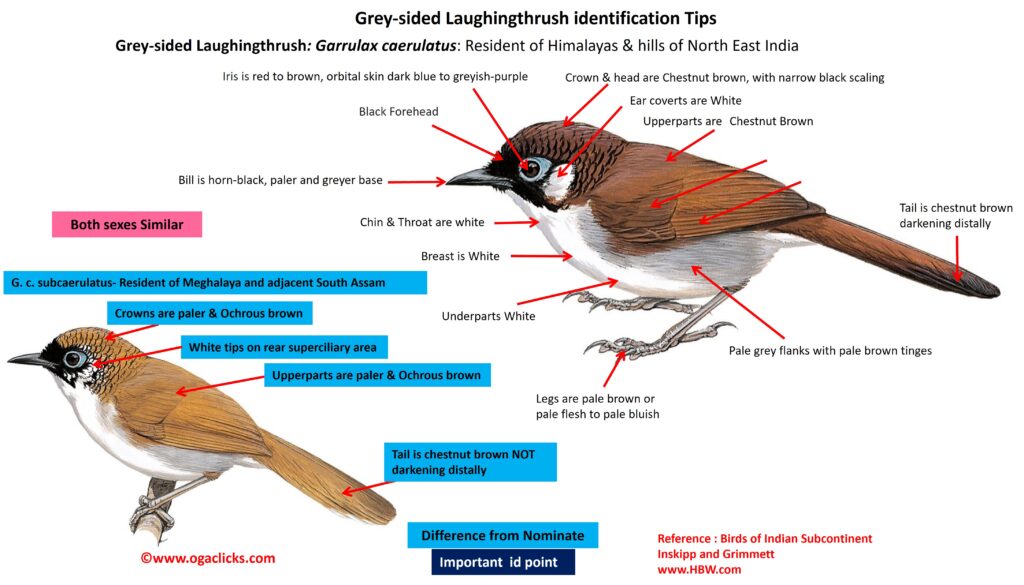
Grey-sided Laughingthrush Garrulax caerulatus
Etymology:
- Garrulax : Latin word garrulous –babbling, chattering; ax – inclining towards
- Caerulatus : Latin word for dark blue derived from caeruleus-blue
Vernacular Name : Lepcha: Tarma-pho, Bhutia: Piang-kam.
Sub Species :
- Nominate – Resident of Arunachal Pradesh ( except south east area)
- c. subcaerulatus- Resident of Meghalaya and adjacent South Assam { paler and more ochrous above, with white on ear-coverts, white tips on rear superciliary area and cheeks, broad white tips on outer tail}
- c. livingstoni- Resident of South East Arunachal Pradesh South to North Manipur { richer rufescent above, little white on ear-coverts, stronger scaling on crown}
Distribution in India :
- Nominate – Resident of Arunachal Pradesh ( except south east area)
- c. subcaerulatus- Resident of Meghalaya and adjacent South Assam
- c. livingstoni- Resident of South East Arunachal Pradesh South to North Manipur
Description: It has a size of 27–29 cm; wt.of 79–99 g. It is a fairly large laughingthrush, rich brown above and whitish below, with grey flanks and black face. The nominate race has crown to upperwing as chestnut-brown, with neat narrow black scaling on crown and paler fringes of wing feathers, tail darkening distally. It has bristly lores and forehead is blackish, black extending just above and below eye with variable amount of white on ear-coverts (sometimes merely white streaks on lower ear-coverts, sometimes completely white; partly an age-related factor). The submoustachial is chestnut brown; chin to vent is white, flanks and thighs are pale grey with slight pale brown tinges. The iris is red to brown, orbital skin is dark blue to greyish-purple; bill is horn-black, paler and greyer base; legs are pale brown or pale flesh to pale bluish. Both the sexes are similar. The juvenile lacks black scaling on crown, and has flanks and undertail-coverts tinged brown. Race subcaerulatus is paler and more ochrous above, with white on ear-coverts, white tips on rear superciliary area and cheeks, broad white tips on outer tail; livingstoni is richer rufescent above, little white on ear-coverts, stronger scaling on crown; kaurensis has white tail tips but otherwise like nominate; latifrons has thicker black scaling on crown and more extensive black forehead.
Habitat: It is found in undergrowth, including bamboo thickets in broadleaf evergreen forest, scrub, undergrowth in pine forest, mixed oak and rhododendron forest. It is found at 600–2745 m.
Food habits: It eats Berries, seeds and other vegetable matter; also invertebrates. It is found in Non-breeding season in parties of 3–15 or more individuals, sometimes in association with other laughingthrushes. It forages in low bushes and on ground, occasionally in taller trees.
Breeding habits: They breed in Apr–Jul. the nest is a large, compact, rather shallow to deep cup, made of bamboo leaves, broad grass leaves, coarse grasses, twigs, creeper stems and vegetable fibre, lined with rootlets, root fibres, moss roots and fine grasses, placed above ground, in bush, bamboo clump or tree. They lay a clutch of 2–3 eggs. They are subjected to brood parasitism by Chestnut-winged Cuckoo.